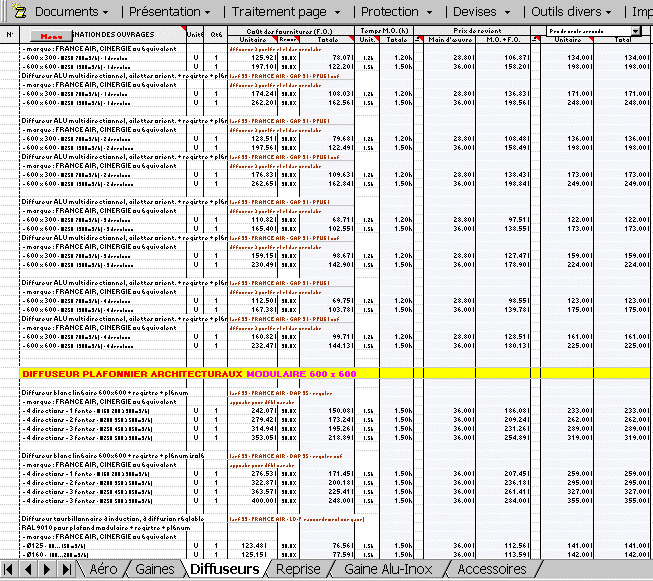| softwares, computation, programs, construction, building, builder, dataBase, library, cost, costing, estimate, estimates, quotation, quotations, heating, steam, ventilation, air, conditioning, plumbing, gas, fire, protection, system, smoke, clearing. |
| _You are in the heading |
|
|
Carried out an estimate by imputing the necessary values such as the price of the materials supplies, the discounts, the labor time, for each study in spite of automatic calculation can to be proved long and tiresome. The solution will consist to create libraries in catalog sheets, established on identical tables of estimate. The technique to be used will consist simply in opening the files of the library and to carry out a "Copy / Paste" by insertion on the places concerned. Calculations will establish automatically by taking again the mark-up, the labor rate pre-established on the working sheet of the estimate in progress. Libraries (See the annotation below)
In this file of library "duck work" (above example), the duck elements are shared out on various working sheets, facilitating by consequence the retrieval of data. Useful elements devoted to the creation of the library such as tariff date, the brand and the type of products and various other types of information are placed on the columns reserved for spent study. The creation of estimate by this method proves to be very effective, sometimes it is simply enough to insert a module of study of price carried out on another operation and to withdraw the elements which are not necessary on this one and to add the missing elements. These databases can be used for any cost estimate. If these margin percentage change, cost estimates can be rapidly re-computed after the databases are updated. Labor The labor cost for each item is expressed by an average time rate for a given team. These time rates integrate the payroll charges. They also take into account the paid-leaves, premiums and allowances day laborers of meal and transport, unproductive times and the effect of possible overtime. You will have to personalize your average time rate according to your principal activity, of your area, the size of the company, and the real wages of the workmen and the composition of the teams. The evaluation of times of labour includes all the work with the installation of described materials. These evaluations are established under standard conditions: experienced workmen working in new building. The evaluations of labor also suppose that the materials are of standard category, that the use of the suitable tools is completely mastered, that the provision of the installation is not very complicated. All the evaluations of time of labor include tasks like:
Labor Adjustment If the work you're estimating won't be done under these conditions, you need to apply a correction factor to adjust the man-hour estimates in this book to fit your job. Employ one or more factors of correction recommended in "below table" to adjust itself in the specific conditions of work. To make the adjustment, multiply the evaluation of the time of labor by the suitable factor of conversion. On certain work, several factors of correction can be necessary. A factor less than 1.00 of correction means that the favourable working conditions will reduce times of labor required.
Last update:
|
Copyright © 2003-2014 - ThermExcel - All Rights Reserved
